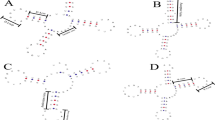Abstract
The intron located between the first and the second nucleotide of the leucine tRNA anticodon is the only representative of the group I introns in higher plants. In this work, the intron sequence of the plastid trnL gene was for the first time described in 16 legumes species and putative secondary structures of the full-length intron and its functional domains were reconstructed. A high level of polymorphism was detected for this intron in the Fabaceae genera and in the species within a single genus. Single nucleotide polymorphisms, have been found in the sequences of the catalytic center which are considered to be highly conservative.
Similar content being viewed by others
References
Borsch, T., Hilu, K.W., Quandt, D., Wilde, V., Neinhuis, C., and Barthlott, W., Noncoding plastid trnT-trnF sequences reveal a well resolved phylogeny of basal angiosperms, J. Evol. Biol., 2003, vol. 16, pp. 558–576.
Gielly, L., Yuan, Y.-M., Kupfer, P., and Taberlet, P., Phylogenetic use of noncoding regions in the genus Gentiana L.: chloroplast trnL (UAA) intron versus nuclear ribosomal internal transcribed spacer sequences, Mol. Phylogenet. Evol., 1996, vol. 5, no. 3, pp. 460–466.
Kupicha, F.K., The infrageneric structure of Vicia, Notes from the Royal Botanic Garden, Edinburg, 1976, vol. 34, no. 3, pp. 287–326.
Nielsen, H. and Johansen, S.D., Group I introns, RNA Biol., 2009, vol. 6, no. 4, pp. 375–383.
Oskoueiyan, R., Osaloo, S.K., Maassoumi, A.A., Nejadsattari, T., and Mozaffarian, V., Phylogenetic status of Vavilovia Formosa (Fabaceae-Fabeae) based on nrDNA ITS and cpDNA sequences, Biochem. Syst. Ecol., 2010, vol. 38, pp. 313–319.
Paquin, B., Kathe, S.D., Nierzwicki-Bauer, S.A., and Shub, D.A., Origin and evolution of group I introns in cyanobacterial tRNA genes, J. Bacteriol., 1997, vol. 179, pp. 6798–6806.
Schaefer, H., Hechenleitner, P., Santos-Guerra, A., Menezes de Sequeira, M., Pennington, R., Kenicer, G., and Carine, M.A., Systematics, biogeography, and character evolution of the legume tribe Fabeae with special focus on the middle-Atlantic island lineages, BMC Evol. Biol., 2012, vol. 12, p. 250.
Slugina, M.A., Snigir’, E.A., Ryzhova, N.N., and Kochieva, E.Z., Structure and polymorphism of a fragment of the Pain-1 vacuolar invertase locus in Solanum Species, Mol. Biol. (Moscow), 2013, vol. 47, no. 2, pp. 215–221.
Summons, R.E., Jahnke, L.L., Logan, G.A., and Hope, J.M., 2-Methylhopanoids as biomarkers for cyanobacterial oxygenic photosynthesis, Nature, 1999, vol. 398, pp. 554–557.
Taberlet, P., Coissac, E., Pompanon, F., Gielly, L., Miquel, C., Valentini, A., Vermat, T., Corthier, G., Brochmann, C., and Willerslev, E., Power and limitations of the chloroplast trnL (UAA) intron for plant DNA barcoding, Nucleic Acids Res., 2007, vol. 35, no. 3, p. e14.
Tamura, K., Peterson, D., Peterson, N., Stecher, G., Nei, M., and Kumar, S., MEGA5: molecular evolutionary genetics analysis using maximum likelihood, evolutionary distance, and maximum parsimony methods, Mol. Biol. Evol., 2011, vol. 28, pp. 2731–2739.
Weeden, N.F., Genetic changes accompanying the domestication of Pisum sativum: is there a common genetic basis to the ‘domestication syndrome’ for legumes?, Ann. Bot., 2007, vol. 100, pp. 1017–1025.
Won, H. and Renner, S.S., The chloroplast trnT–trnF region in the seed plant lineage Gnetales, J. Mol. Evol., 2005, vol. 61, pp. 425–436.
Yulita, K.S., Secondary structures of chloroplast trnL intron in Dipterocarpaceae and its implication for the phylogenetic reconstruction, Hayati J. Biosci., 2013, vol. 20, no. 1, pp. 31–39.
Zhou, Y., Lu, C., Wu, Q.-J., Wang, Y., Sun, Z.-T., Deng, J.-C., and Zhang, Y., GISSD: Group I intron sequence and structure database, Nucleic Acids Res., 2008, vol. 36, pp. D31–D37.
Zuker, M., Mfold web server for nucleic acid folding and hybridization prediction, Nucleic Acids Res., 2003, vol. 31, pp. 3406–3415.
Author information
Authors and Affiliations
Corresponding author
Additional information
Original Russian Text © E.A. D’yachenko, M.A. Filyushin, E.P. Pronina, E.Z. Kochieva, 2014, published in Vavilovskii Zhurnal Genetiki i Selektsii, 2014, Vol. 18, No. 4/1, pp. 724–731.
Rights and permissions
About this article
Cite this article
D’yachenko, E.A., Filyushin, M.A., Pronina, E.P. et al. Variability of the trnL plastid gene’s intron in the Faboideae species (Fabaceae). Russ J Genet Appl Res 5, 220–226 (2015). https://doi.org/10.1134/S2079059715030053
Received:
Accepted:
Published:
Issue Date:
DOI: https://doi.org/10.1134/S2079059715030053



